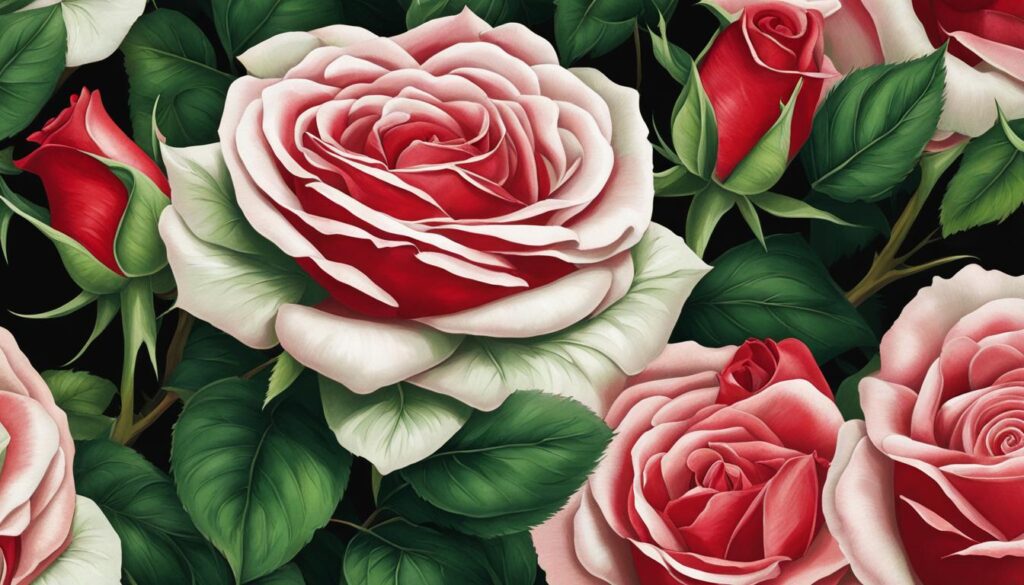Are you noticing red leaves on your roses? While it can be a normal part of growth, it can also indicate potential problems with your rose bush’s health. Understanding the common causes of red leaf discoloration is crucial for maintaining a thriving rose garden.
When new foliage emerges, it often starts out with a deep red or purple color, which gradually changes to green as it matures. This is a natural process and a sign of a healthy rose bush. However, if the edges of the leaves appear dry or broken, it could be a sign of heat stress burn or chemical burning.
If the leaves turn a bright red color, look distorted or elongated, and the foliage appears crinkled, it could be a warning sign of a serious disease called Rose Rosette. This disease is fatal and requires the infected bush and surrounding soil to be removed and destroyed.
Red leaves can also be caused by frost damage, which typically turns the foliage a mottled red and yellow color. Differentiating between normal growth and potential problems is essential for maintaining a healthy rose garden.
Stay tuned to learn more about the common causes of red leaves on roses and how to maintain a healthy rose garden.
Common Causes of Red Leaves on Roses
The red coloration of rose leaves can occur due to various factors. Understanding these common causes can help identify and address issues related to red leaves on roses.
- New leaves on rose bushes: New leaves on rose bushes can naturally start out red or burgundy and gradually change to green as they mature. This is a normal growth process and signifies a healthy bush.
- Heat stress burn or chemical burning: If the leaves develop dry or broken edges, it may indicate heat stress burn or chemical burning caused by herbicide spray drift.
- Frost damage: Frost damage can cause the leaves to turn red or reddish-brown around the edges.
- Rose Rosette disease: In the case of knockout rose bushes, red foliage can be a potential warning sign of the Rose Rosette disease. This fatal viral infection causes the leaves to turn red or a combination of red, yellow, and green. The stems may become thick and thorny, and the leaves can appear curled or distorted.
Identifying the specific cause of red leaves on your roses is essential for appropriate treatment and maintaining the overall health of your rose bushes.
Maintaining a Healthy Rose Garden
To ensure the health and beauty of your rose garden, there are several care tips you can follow. Firstly, provide adequate water and proper drainage to prevent waterlogged soil, which can lead to root rot and other problems. Water your rose bushes deeply, but avoid overwatering as it can cause stress to the roots.
Regularly inspect your roses for signs of pests and diseases. Aphids, spider mites, and blackspot are common issues that can affect rose bushes. Employ appropriate preventive measures like using insecticidal soap or neem oil for pests, and fungicides for diseases. Ensure you follow the instructions carefully to prevent damage to the plants.
Avoid using chemical sprays near your roses that could potentially cause damage or herbicide drift. Chemicals such as weed killers or pesticides can harm the delicate foliage and roots of the rose bushes, leading to red leaves and other health issues. Instead, opt for organic options whenever possible.
Prune your roses regularly to remove dead or diseased foliage, promote healthy growth, and maintain the desired shape of the bush. Use sharp and clean pruning shears or scissors to make clean cuts just above an outward-facing bud. This encourages new growth and improves air circulation among the branches, reducing the risk of diseases.
Mulching around the base of the plants can help conserve moisture, suppress weeds, and provide insulation during colder months. Apply a layer of organic mulch, such as wood chips or compost, around the roses, avoiding direct contact with the stems. This also helps in preventing soil-borne diseases and maintaining overall plant health.
Finally, pay attention to the overall health of your roses, including leaf color, growth rate, and any abnormal signs. Early detection of issues can prevent them from escalating and causing widespread damage. With consistent care and attention, you can promote the health of your rose bushes, prevent red leaves, and ensure a thriving garden.
Can Almond Trees and Roses Be Planted in the Same Growing Zone?
Yes, almond trees and roses can be planted in the same growing zone, with the ideal almond growing zones typically ranging from USDA zones 7-9. Both plants can thrive in well-drained soil and full sunlight, making them compatible choices for the same garden environment.










